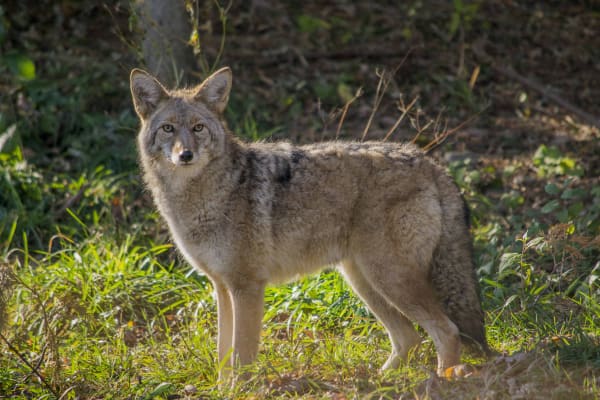State Rep. Greg Markkanen on Thursday was joined by Rep. Dave Prestin in announcing his bill to restore hunters’ rights, allowing them to hunt coyotes year-round.
The plan, House Bill 5721, allows an individual who holds a fur harvester’s license to hunt coyotes year-round. The legislation comes in response to the Natural Resources Commission, which regulates state wildlife and management, shortening Michigan’s public coyote hunting season by three months and declaring a stretch from mid-April to mid-July off limits.
“Allowing coyotes to run unchecked is simply not an option,” said Markkanen, R-Hancock. “These predators don’t care about seasons or regulations; they’re a constant threat to our livestock, pets, and even our children. We can’t afford to tiptoe around the issue. It’s time to face reality: we need to hunt coyotes year-round, no excuses, no exceptions.”
Markkanen and Prestin introduced a legislative package earlier this term to create an Upper Peninsula NRC. Under their proposal, the newly formed NRC would be comprised of only U.P. residents and would set hunting and fishing rules for everything north of the Mackinac Bridge. The bill has yet to receive a hearing in the Democrat-controlled House Committee on Natural Resources
“The NRC admitted there are too many coyotes,” Markkanen said. “Every member was appointed by Gov. Whitmer, and the law says they have to use sound science. Instead, they caved to political pressure from anti-hunting liberal activists. Their order is pure politics.”
Last month, a coyote attacked a sheep at the Greenfield Village open-air history museum in Dearborn, a city with a population of over 100,000 people.
While hunters are still able to kill nuisance coyotes year-round on private land without a permit, Prestin and Markkanen noted that the provision only covers certain situations, like emergency instances, and true management is being restricted with the new parameters.
The Natural Resources Commission’s decision to limit the coyote hunting season has been challenged in court by a prominent lower Michigan conservation club. Other groups have come out publicly against the decision.
“Coyote hunting plays a critical role in maintaining ecological balance and protecting our communities,” said Prestin, R-Cedar River. “Coyotes are resilient predators whose populations can quickly grow unchecked, posing threats to livestock and pets. By supporting year-round coyote hunting, we uphold our responsibility to manage wildlife populations responsibly.”
The bill was referred to the House Natural Resources, Environment, Tourism and Outdoor Recreation Committee for consideration.
- Ontonagon Man Arrested for Child Sexually Abusive Activity - June 27, 2025
- Bump stocks, ghost guns targeted in bills passed by Michigan Senate - June 26, 2025
- Senate panel backs opioid addiction, overdoes treatment access package - June 26, 2025





According to the American Veterinary Medical Association, the U.S. Centers for Disease Control (CDC) had reported over 4.5 million people are bitten by dogs every year in the U.S with over 800,000 instances where medical attention is received and the most common victims being children.
How many Coyote fatalities have there been Greg?
It’s a proven fact that the more you kill Coyotes the faster they will reproduce with even larger litters. You are only adding to the problem.
It’s ignorant politicians like this that have no clue what they are doing.
Why Killing Coyotes Doesn’t Work
The coyote, our unique Song Dog who has existed in North America since the Pleistocene
Epoch, is the most persecuted native carnivore in North America and the most frequent
victim of wildlife killing contests. Killed for prizes, poisoned, trapped, and aerial gunned,
an estimated half a million coyotes—one per minute—are slaughtered every year in the
United States.
The best available, peer-reviewed science shows that indiscriminately killing coyotes is
counterproductive and a threat to healthy ecosystems. There is no credible evidence that
indiscriminate killing of coyotes effectively serves any beneficial wildlife management
purpose. Over 70 prominent conservation scientists condemn coyote killing contests—
their signed statement is available here.
Coyotes play a crucial ecological role and provide a range of free, natural
ecological services in urban and rural settings.
Coyotes directly or indirectly help to control disease transmission, keep rodent
populations in check, consume animal carcasses, increase biodiversity, remove sick
animals from the gene pool, and protect crops. Unexploited coyote populations can
contribute to ecosystem health through trophic cascade effects such as indirectly
protecting ground-nesting birds from smaller carnivores and increasing the biological
diversity of plant and wildlife communities.1 State wildlife management agencies across
the country recognize the benefits that coyotes provide to ecosystems.
Indiscriminately killing coyotes does not reduce their populations—in fact, it can
have the opposite effect.
It is nearly impossible to permanently reduce coyote populations.2 More than 100 years
of coyote killing has failed to do that. Since 1850—when mass killings of coyotes began—
coyotes’ range has tripled in the United States.3 Indiscriminate killing of coyotes
stimulates increases in their populations by disrupting their social structure, which
encourages more breeding and migration.4 Unexploited coyote populations are self-
regulating based on the availability of food and habitat and territorial defense by resident
family groups. Typically, only the dominant pair in a pack of coyotes reproduces, and they
behaviorally suppress reproduction among subordinate members of the group. When
one or both members of the dominant pair are killed, socially bonded packs break up,
and subordinate members disperse, find mates and reproduce. More coyotes breed at
younger ages, and more pups survive following a temporary increase in available prey.
These factors work synergistically to increase coyote populations following exploitation
events
I was examining some of your articles on this website and I think this internet site
is rattling instructive! Retain putting up.Money from blog